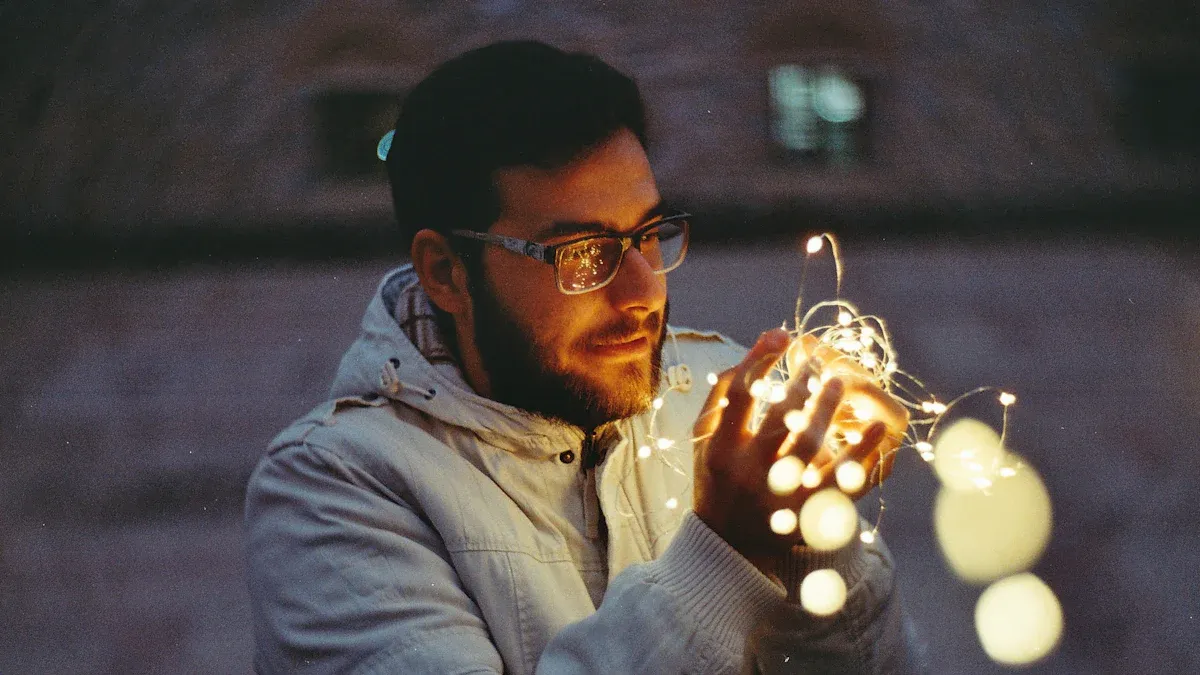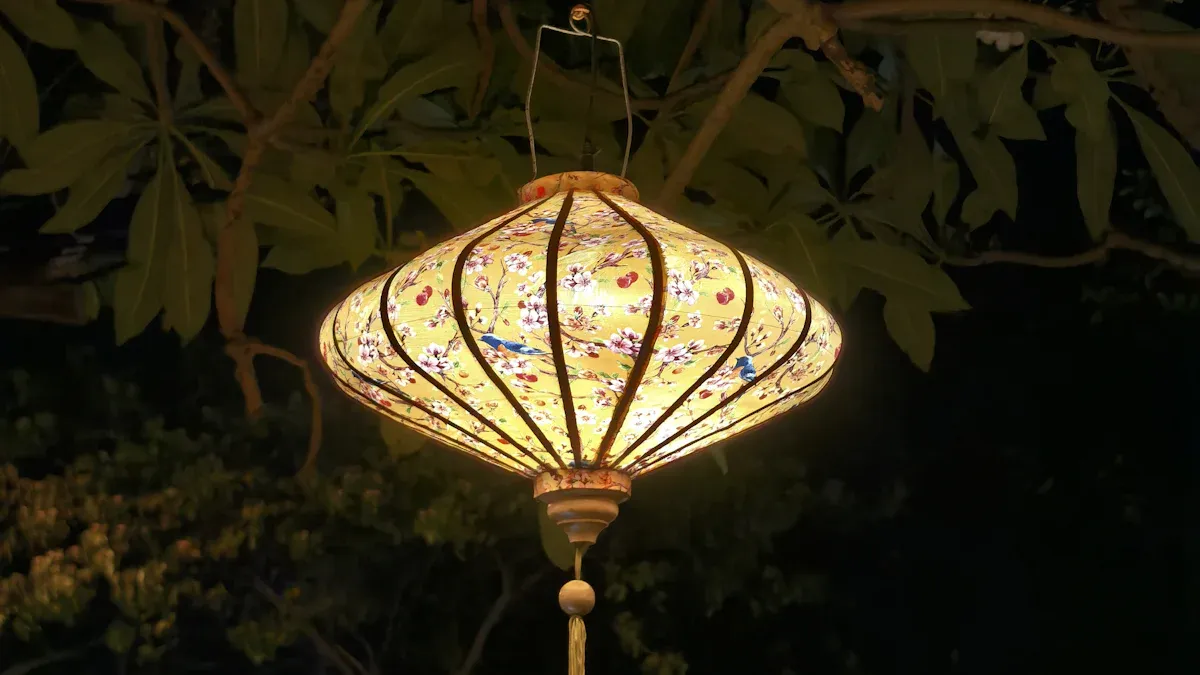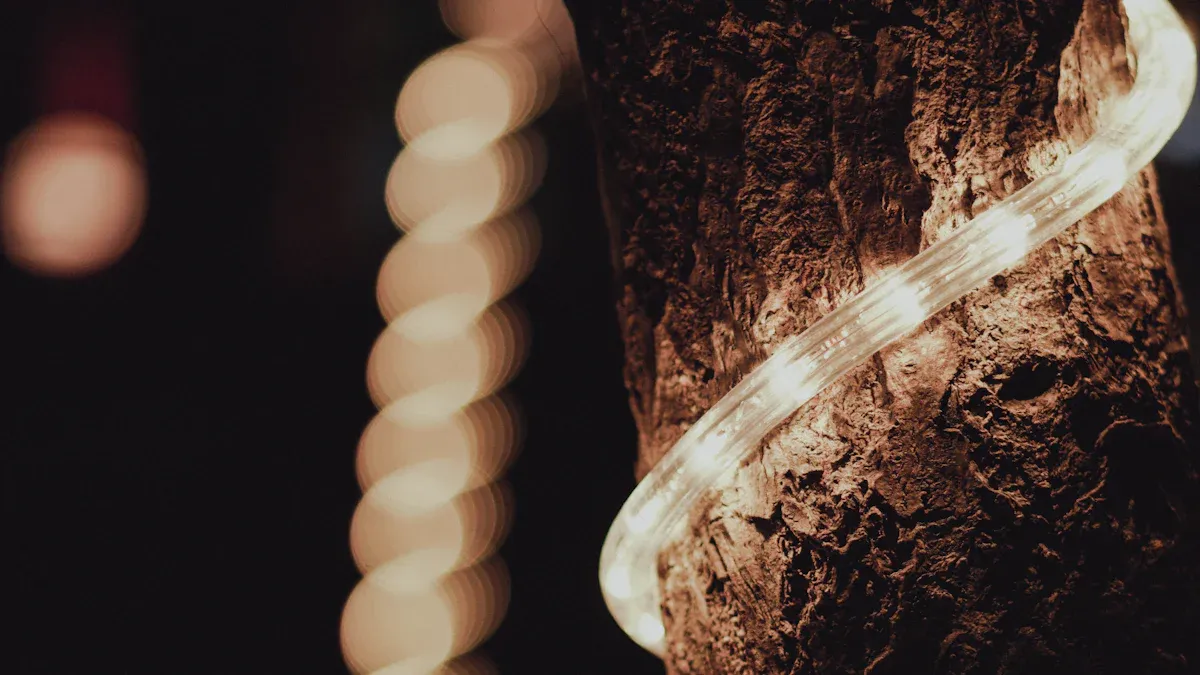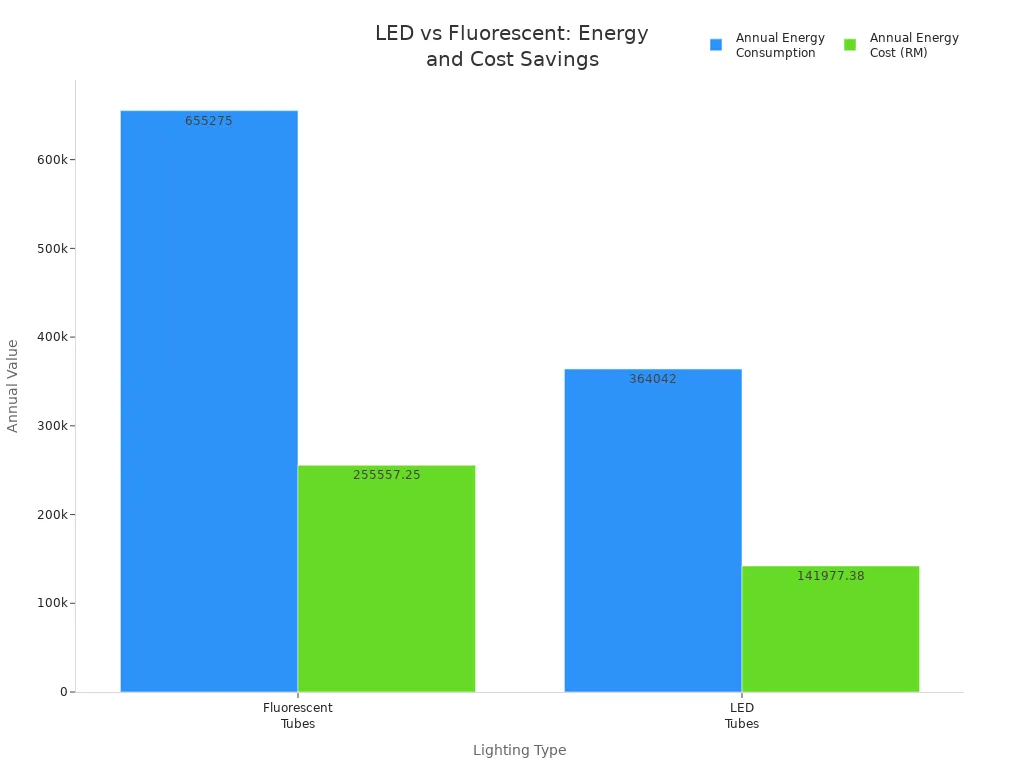Choose Perfect Paper LED Light for Your Display Projects

Ever wonder how to choose perfect paper led light for your project? Picking the right light can make your paper art shine or help your display stand out. You want a light that works well with your paper, whether you use thin tracing sheets or thick cardstock. The right choice keeps your project safe and helps colors pop. If you love diy or small projects, finding the best paper led can feel tricky. With simple tips, you can choose perfect paper led light and make your next paper project a real success!
Key Takeaways
Pick LED lights that do not get hot and shine light evenly. This helps keep your paper safe and makes your display look nice. - Use bendable LED sheets or panels for bright, smooth light. They can fit any shape or design you want. - Change the brightness and color temperature to match your paper. This helps set the right mood for your project. - Try out your lighting before you finish. This makes sure the colors look right and your paper does not get damaged. - Buy good LED strip lights from sellers you trust. Check if they have warranties so your lights last long and save energy.
Choose Perfect Paper LED Light

When you want to choose perfect paper led light for your display, you need to know what makes one stand out. Not all lights work the same way, especially when you use them with paper. The right lighting can make your project look amazing and keep your paper safe. Let’s break down what you should look for and why these features matter.
Key Features
You want your display to look bright and clear, but you also need to protect your paper. Here are the most important features to check when you choose perfect paper led light:
Low Heat Emission: Some lights get hot and can damage delicate paper. LEDs stay cool, so your project stays safe.
Uniform Light Distribution: Even lighting means no harsh spots or shadows. This helps your paper art or display look smooth and easy to see from any angle. Matte or antiglare surfaces help scatter the light, so you don’t get glare that hides your work.
Adjustable Brightness and Dimming: You can control how much light you need. This is great for different types of paper or if you want to change the mood.
Color Temperature Control: Warm light (around 2700K) feels cozy, while cool light (up to 6500K) looks crisp and clear. Picking the right color temperature helps your colors look true and your display feel just right.
Mounting Options: LEDs come in different types, like surface-mounted or through-hole. Some have sticky backs, so you can place them exactly where you want.
Diffusers: These help spread the light evenly and cut down on glare, especially if your paper is glossy.
Power and Compatibility: Make sure the LED matches your power source and works with your paper type. Check the datasheet for details like voltage and current.
Durability: Some LEDs use special coatings to protect against humidity and UV light. This keeps your project looking good for a long time, even if you move it around.
Tip: Always test your lighting setup before you finish your project. This way, you can see how the light looks with your paper and make changes if needed.
You’ll find that LED light sheets and flexible LED matrix panels work really well for paper displays. Light sheets are thin, flexible, and easy to cut, so you can fit them to any shape. Flexible panels can bend or curve, which is perfect for creative or 3D displays. Both types give you bright, even lighting and are simple to install.
Benefits
Using LED lights designed for paper displays gives you a lot of advantages. Here’s a quick look at why you should choose perfect paper led light for your next diy or art project:
Benefit | Why It Matters |
|---|---|
Reduced Power Usage | LEDs use less energy, so your project costs less to run and is better for the environment. |
Easy to Adjust and Install | Flexible panels and light sheets are simple to cut, bend, and stick where you need them. |
Better Quality of Light | Uniform, adjustable lighting makes your display look professional and easy to read. |
Protects Your Paper | Low heat and special coatings keep your paper safe from damage and fading. |
Customizable Lighting | You can change brightness, color, and even add effects for a unique look. |
Long Lifespan | LEDs last a long time, so you don’t have to replace them often. |
Improved Portability | Lightweight and flexible lights make it easy to move or change your display. |
When you choose perfect paper led light, you get more control over how your project looks and feels. You can highlight details, show off colors, and make sure your display stands out. The right lighting also helps people see your work clearly, no matter where they stand.
If you want your paper display to look its best, focus on the quality of light, even brightness, and how well the lighting works with your materials. Flexible LED matrix panels and LED light sheets give you the freedom to create displays that are both eye-catching and safe for your paper. With these features and benefits, you can turn any idea into a standout project.
LED Strip Lights and Other Types

When you start a paper display project, you have many choices for lighting. Each type of LED brings something special to your setup. Let’s look at the most popular options and see how they work for different needs.
LED Strip Lights
You will find that LED strip lights are one of the easiest ways to add light to your display. These strips come in many types of LED strips, including SMD and COB. You can bend, cut, and shape them to fit almost any design. LED strip lights stick to surfaces with self-adhesive backing, so you can install them quickly. They work well for accent lighting, outlining shapes, or illuminating a specific spot on your paper art. You can pick from many LED strip colors, from warm white to bright RGB. LED strip lights use little energy and last a long time. They stay cool, which keeps your paper safe. Some LED strip lights may lose their stickiness over time, so make sure your surface is clean and dry. If you want bright, flexible lighting, LED strip lights are a great choice.
LED Light Sheets
LED light sheets give you smooth, even lighting across large areas. These sheets look like thin panels filled with tiny LEDs. You can cut them to fit your project and even bend them a little for curved displays. LED light sheets use special designs to spread light evenly, so you don’t see hot spots or dark patches. This makes them perfect for backlighting signs, posters, or any paper that needs a soft, uniform glow. You can also adjust the brightness and color to match your display. LED light sheets cost more than strips, but they give you a professional look. They are great for projects where you want every part of your paper to shine the same way.
Flexible Panels
Flexible panels take LED lighting to the next level. These panels use LEDs on bendable boards, so you can twist, fold, or curve them without breaking. Flexible panels are thin and light, making them easy to hide behind paper. You can use them for creative shapes, 3D displays, or any project that needs lighting in unusual places. Flexible panels keep their brightness and color, even when you bend them. Some new panels are as thin as paper, letting you create displays that look almost magical. You can connect panels with simple push-fit connectors, so setup is fast and easy. If you want to try something new, flexible panels open up a world of creative lighting.
Tip: Try combining LED strip lights, LED light sheets, and flexible panels for unique effects. You can mix and match to get the perfect look for your paper display.
Type | Best For | Light Quality | Flexibility | Cost |
|---|---|---|---|---|
LED Strip Lights | Outlining, accent, spot lighting | Bright, can have spots | Very flexible | Low |
LED Light Sheets | Backlighting, large even surfaces | Uniform, no spots | Some flexibility | Medium-High |
Flexible Panels | Curved, 3D, creative displays | Uniform, customizable | Highly flexible | High |
You can also explore new LED technology like paper-thin flexible LED matrix panels. These panels let you create displays that bend, fold, and even move. With so many lighting options, you can make your paper project stand out in any space.
Specifications to Consider
When you pick lighting for your paper display, you want to get the details right. The right specs make your project shine and keep your paper safe. Let’s break down what you need to know about brightness, color temperature, wattage, and paper compatibility.
Brightness
Brightness is one of the most important things to check. If you use your display for reading, you need led lights that give off at least 500 lumens. This level of brightness helps you see clearly and keeps your eyes from getting tired. For detailed work, you might want up to 1100 lumens. If you just want a soft glow for decoration, you can use much lower brightness. Decorative lighting usually sits around 50 to 150 lux, which feels gentle and cozy. Always match your led strip brightness to your project’s goal. Too much brightness can wash out colors or make your paper look harsh, while too little makes details hard to see.
Color Temperature
Color temperature changes how your paper display feels. Warm lighting (about 2700K to 3000K) gives off a yellowish glow. This makes your space feel comfortable and relaxed. It also brings out red and orange tones in your paper. Cool lighting (5000K to 6500K) looks more like daylight. It makes whites look crisp and helps you see fine details. If you want your display to feel modern and sharp, go for cooler color temperatures. For a cozy, nostalgic mood, stick with warmer lighting. The right color temperature can even change how people feel when they look at your display.
Wattage
Wattage tells you how much energy your lighting uses. Led lights use much less power than old bulbs. Most led lighting for paper displays uses between 4 and 10 watts. This means you save money on your electric bill and don’t have to change bulbs as often. Check the energy efficiency rating when you shop for lighting. High efficiency means more brightness for less power. Take a look at this chart to see how much energy you can save with led lighting:

Tip: Always check the power factor if you plan to run your lighting for a long time. This helps you avoid surprise costs.
Paper Compatibility
Not all paper works the same with lighting. Thin paper, like mulberry or tracing paper (25-70 gsm), lets more light through and spreads brightness evenly. This makes your display glow softly. You can also use plain printer paper as a diffuser in shadow boxes. It helps spread the light and keeps it from looking spotty. Led lighting is safe for most paper because it stays cool. For extra safety, you can treat your paper with fire-retardant spray or mount it on a plastic base. Layering thin paper can also make your lighting look smoother and protect your display.
Note: Always test your lighting with your chosen paper before you finish your project. This way, you can see how the brightness and color look together.
Installation and Safety Tips
Easy Setup
Setting up lighting for your paper display can feel easy when you use the right tools. Many people start with paper circuit kits because they include everything you need for a simple project. You can use copper tape to make reliable connections. Try to use one long piece of copper tape for each path. Smooth it down so it sticks well and keeps the electricity flowing. If you need to turn a corner, fold the tape at a sharp angle. Leave small gaps for your led or other parts. Bend the legs of your led flat and tape them to the copper strip. Make sure the long leg goes to the positive side. You can use clear tape to hold things in place, or solder for a stronger hold. Always check that your battery sits tight and the connections are solid. If your led does not light up, check the direction and make sure the tape is smooth with no wrinkles.
Tip: Paper circuit kits make diy lighting projects fun and safe, even for beginners.
Diffusers
You want your lighting to look soft and even. Diffusers help spread the light so you do not see bright spots. Many people use tracing paper, plain printer paper, or parchment as easy diffusers. These materials cost little and are simple to cut and fit. For a more permanent display, you can try acrylic or polycarbonate sheets. These plastics last longer and handle heat better, but they cost more and need careful cutting. Here is a quick guide:
Diffuser Material | Pros | Cons | Best Use |
|---|---|---|---|
Paper (tracing, bond, tissue) | Cheap, easy to use | Not durable, can get hot | Temporary or decorative displays |
Acrylic/Polycarbonate | Strong, even light | Expensive, harder to cut | Permanent or high-use displays |
Try layering thin paper for a softer glow. Always test your lighting with your chosen diffuser before finishing your project.
Safety
Safety matters when you work with lighting and paper. Paper can burn if it gets too hot, so always use led lights because they stay cool. Keep some space between your lighting and the paper. Avoid letting wires or copper tape touch each other by accident. Never stare straight into bright led lights. Blue and UV light can hurt your eyes. Pick lighting with a warm color temperature if you plan to use your display at night. This helps protect your sleep. If you notice flicker or glare, try a different power source or move your lighting. Always follow the instructions in your paper circuit kits and test your setup before leaving it on for a long time.
Note: Good installation of led strip lights and careful testing help prevent most problems with paper lighting projects.
Buying LED Strip Lights
What to Look For
When you start buying led strip lights for your paper display, you want to make sure you get the best fit. Here’s a handy checklist to help you choose:
Decide what you need. Think about color temperature, brightness, and how wide you want the light to spread.
Check the quality. Look for a high color rendering index (CRI 90 or above) so your colors look true.
Pick trusted brands. Choose suppliers who have good reviews and clear product details.
Ask for a warranty. A good warranty should cover both sudden failures and slow changes in brightness or color.
Try before you buy. Order a small sample and test it at home.
Test in your real setup. Put the sample in your display for a week. Watch for overheating or color changes.
Look at the light. Make sure it looks even and doesn’t have glare or weird shadows.
Test the controls. If your led strip lights have dimmers, check that they work smoothly.
Think about savings. Check how much energy you’ll save over time.
Write down what you buy. Keep track of the model, specs, and when you installed it.
Tip: Always test your led strip lights in your actual display before buying led strip lights in bulk. This helps you spot any problems early.
You should also think about the size and shape of the led strip lights. Make sure they fit your project and match your decor. Easy installation is a big plus, especially if you want to change your display often.
Where to Buy
You can find led strip lights in many places, but not all sellers offer the same quality. DHgate is a popular online store for buying led strip lights. They offer high-quality options with features like waterproofing, flexible adhesive backing, and a two-year warranty. You get fast shipping and helpful customer support. Always read reviews and check return policies before buying led strip lights from any store.
Before you finish your project, test your led strip lights with these methods:
Test Type | What to Check |
|---|---|
Brightness & Color | Use your eyes or a light meter |
Power Use | Check if it gets too hot |
Durability | Try bending or moving the strip |
Visual Inspection | Look for even light and no flicker |
Buying led strip lights gets easier when you follow these steps. You’ll end up with a display that looks great and lasts a long time.
When you pick the right paper LED light, focus on what matters most for your project. Look at things like brightness, color, energy use, and how easy it is to install. Make sure your LED type and specs match your setup so your display shines evenly and safely.
Don’t be afraid to try new ideas or mix different lights. You might discover a creative way to make your display stand out!
FAQ
What type of LED works best for thin paper?
You should use LED light sheets or flexible panels. These spread light evenly and stay cool. Thin paper, like tracing paper, glows softly with these lights. You get fewer hot spots and your project looks smooth.
Can I cut LED strip lights to fit my project?
Yes! Most LED strip lights have marked cut points. You can trim them with scissors. Always cut on the line. After cutting, use connectors or solder to attach wires. Check the instructions for your specific strip.
How do I keep my paper from overheating?
Stick with LED lights because they produce very little heat. Leave a small gap between the light and the paper. Test your setup before leaving it on for a long time. If the paper feels warm, add more space or use a diffuser.
What is the best way to hide wires in my display?
You can run wires behind your paper or along the frame. Use thin copper tape for paper circuits. Clear tape helps hold wires in place. Try to match wire color to your background for a cleaner look.
Can I use colored LEDs for my paper art?
Absolutely! Colored LEDs add fun effects to your display. You can mix colors or use RGB strips for changing lights. Test different colors with your paper to see which ones look best. Some colors may look brighter or softer depending on the paper.
See Also
Selecting Ideal Acrylic Panels For Effective Light Box Displays
Finding The Best Wall Mount System For LED Light Boxes
Guide To Picking The Right Acrylic Sheet For Light Boxes

